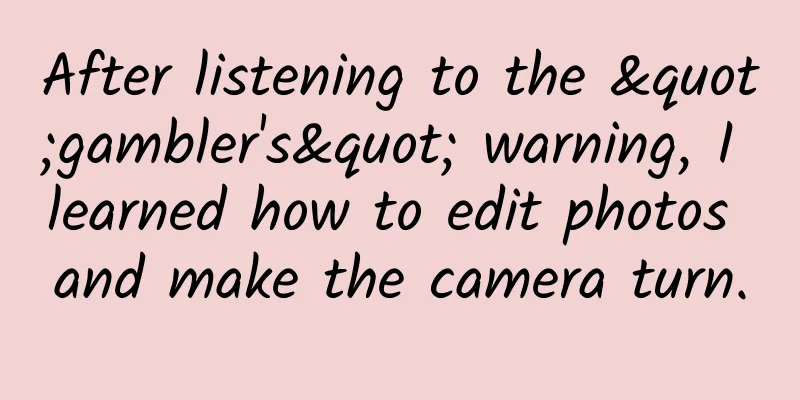After listening to the "gambler's" warning, I learned how to edit photos and make the camera turn.

|
From Grand Theft Auto, The Witcher 3 to Red Dead Redemption, many gamers are addicted to casinos. I wonder if any of them realize that no matter how good their gambling skills are, they can’t get the slightest advantage from the casinos. Macau gambling king Stanley Ho also said: “Not gambling is winning.” Gambling is doomed to lose money, which is determined by a mysterious law that governs everything. And what else can we do with this mysterious law? Why do you always lose when you gamble? In Macau, Las Vegas, Atlantic City, Monte Carlo and other major casinos around the world, the most common game is Russian roulette. There are 37 numbers written on the roulette wheel, from 0 to 36. The ball will stop at a certain number. Gamblers can choose a number in advance to bet the principal, with odds of 1:35. If they guess wrong, the "principal" will be swallowed by the casino, but if they guess right, not only will the "principal" be returned, but an additional 35 times will be awarded, that is, 1 yuan will become 36 yuan. On the surface, it seems to be "very profitable", but in fact, the probability of guessing the number is only 1/37. The expected value of a 1 yuan investment in the game is 0*(36/37)+36*(1/37)-1=-0.027. On average, gamblers lose money but it is not obvious. For every 100 yuan invested by players, an average of 2.7 yuan will be taken away by the casino (the casino will make a steady profit). Russian roulette (Image source: veer) Another common game in casinos is to bet on the size of the dice by rolling the dice. In the game, three dice are randomly rolled (each with a number from 1 to 6). If the total number is less than or equal to 10, it is considered "small", and if it is greater than or equal to 11, it is considered "big". Gamblers can bet on "big" or "small" in advance, with odds of 1:1. If you guess correctly, 1 yuan will become 2 yuan. It seems fair, but the casino has a trick up its sleeve. It stipulates that when the points of the three dice are the same (such as three 1s, three 2s...three 6s), no matter whether the player bets on big or small, the player loses and the casino wins, so-called "big or small takes all". In this way, no matter how the gambler bets, according to probability calculation, the casino's winning rate rises from 50% to 51.39%, and the player's winning rate also drops from 50% to 48.61%. The gambler's final expected value is still negative. As long as the gambler's expected value for each round is negative and the casino's expected value for each round is positive, even if the casino has only a very small advantage, under the rule of the law of large numbers, as long as the game goes on one round after another, although on the surface it seems that there are random wins and losses in each round, but with the accumulation of times, the casino will definitely defeat the gambler, make the gambler bankrupt and make the casino a fortune. Even if the gambler has a fortune, in the end he can only contribute it all to the casino owner and return empty-handed. The law of large numbers refers to the phenomenon that the arithmetic mean of a random variable sequence converges to the arithmetic mean of the mathematical expectations of the random variables. In simple terms, in the large number of repeated occurrences of random events, there is often a trend of inevitability. For casinos, the law of large numbers means "guaranteed profit". The advantage that casinos have in terms of rules can be seen as a kind of "signal". Each time the signal is measured, it will be interfered by noise (the luck of the game itself). But even if the signal is very weak, as long as the number of measurements is sufficient, the signal submerged by the noise can always be restored. The law of large numbers governs not only casinos and gamblers, but everything else—even when we take a photograph. How do you become a photo editing expert? On a hot summer day, the road in the distance looks like it is trembling and twisting. This is because the hot road makes the air around it move constantly, and the refracted light reaches the human eye in a swaying way. The stars in the sky at night are constantly twinkling for a similar reason, coming from the movement of air at certain locations in the atmosphere. However, this flow is also full of randomness, just like roulette, dice or playing cards. In this case, there is a technique in astronomical observation that relies on "luck" to take good photos, which is called lucky imaging. The specific method is to use a camera to take short exposures and continuously take many photos of the same scene. Due to the ever-changing noise generated by air flow at different time points, the quality of a single photo is full of uncertainty. However, among so many photos, there are always some local areas of some photos with less noise. We integrate and splice all the clearest areas together to get a high-quality photo. Just as the result of a single gamble is difficult to predict and control, but after repeated bets hundreds or thousands of times, the truth will be revealed. Just like a casino is bound to make a profit, although a large amount of noise in a single shot in lucky imaging is inevitable, after multiple shots, the real signal-the image of the object will appear. In May of this year, researchers at the Gemini Observatory in Hawaii, USA, used lucky imaging to take a clear photo of Jupiter. A lucky image of the Zeta Boötis binary star system 181 light-years from Earth was taken. The single photo taken is as bad as the one on the left, but the "Zhuge Liang" synthesized by many "cobblers" is as clear as the one on the right (Image source: Wikipedia [1]) When we usually use smartphones to take pictures, if the ambient light is very dim, there will also be a lot of random noise in the photos. But as long as the HDR function is turned on, the photos will become much clearer. The various HDR and even HDR+ functions of mobile phone photography are actually similar to the lucky imaging of astronomical telescopes. They also quickly take multiple photos of the same object, suppress noise, and finally synthesize a high-quality picture. Left: HDR+ off; Right: HDR+ on[2] (Image source: Google AI Podcast[2]) If there are only one photo, and we want to remove the random noise from it, is there a good way? We can break the whole into pieces, like making a puzzle, cut the photo into many small squares, and then group the relatively similar small squares. A large number of small squares in the same group are equivalent to the same signal being polluted by different random noises, and finally the noise components can be removed together. This image denoising method called BM3D also reveals the "true color" of the image after many repetitions of the "gamble". Select blocks of the same type Comparison of the final photo before and after noise removal (Image source: paper [5]) In short, the law of large numbers applies to photography in this way: as long as you take enough images, you can always get clear ones. A camera that turns In addition to being a master of photo editing, this law may also help us create a "camera that can turn." Imagine if there was a new type of camera that could receive light that could turn corners and capture objects hidden in corners. This would be an invaluable weapon for driverless cars at road bends and commandos performing missions on the battlefield. (Image source: paper[6]) In order to achieve the goal, some researchers came up with a method that can be regarded as an advanced application of the law of large numbers. A laser transmitter is installed next to the camera, which emits a beam of light to the red position on the wall, and then the reflected light shines on the object. The object then reflects the beam of light to the blue position on the wall, and the camera can then take a picture. Does this idea sound good? However, the ideal is full of plumpness, and the reality is very skinny. Due to the random scattering of laser light on the rough wall, the camera does not take a picture of the object, but a messy scene (speckle) as shown below: (Image source: paper[6]) The researchers then adjusted the direction of the laser transmitter and took another photo. Would it be better this time? Unfortunately, the photo was still another frustrating speckle photo. However, although the "truth" of the object could not be captured, the researchers only needed to slightly adjust the angle of the laser transmitter to obtain many different speckle images (large amounts of data) of the same object. There are "secrets" hidden in a large number of random patterns, just like rolling dice. Although the weak signals hidden in them are not the original photos of the object, they also represent the Fourier spectrum intensity of the photo data. (Image source: drawn by the author) Because any photo can be seen as a combination of many different frequency stripes, the difference is that the "ratio" of each stripe is different, just like each brand of milk powder has its own composition ratio. The Fourier spectrum intensity reveals this important ratio information. For example, the "composition ratio" of images with different letters or numbers is very different, which makes it easy to identify them. The researchers first recovered this spectrum information from a large number of speckle images, and then guessed the appearance of the object from the spectrum information. In this way, the object hidden in the corner is "revealed". However, this "turning" camera can currently only restore simple objects in hidden places, and it is still difficult to image complex objects outside the field of view. Conclusion After removing the thick fog of randomness, both the real rules of the casino and the original appearance of the photo are clearly visible before our eyes. Finally, I would like to remind you with the words of the gambling king: Not gambling means winning! References: [1]https://en.wikipedia.org/wiki/Lucky_imaging [2]https://ai.googleblog.com/2014/10/hdr-low-light-and-high-dynamic-range.html [3]Joshi, N. and Cohen, MF, 2010, March. Seeing Mt. Rainier: Lucky imaging for multi-image denoising, sharpening, and haze removal. In 2010 IEEE International Conference on Computational Photography (ICCP) (pp. 1-8). IEEE. [4]Hasinoff, SW, Sharlet, D., Geiss, R., Adams, A., Barron, JT, Kainz, F., Chen, J. and Levoy, M., 2016. Burst photography for high dynamic range and low-light imaging on mobile cameras. ACM Transactions on Graphics (TOG), 35(6), pp.1-12. [5]Dabov, K., Foi, A., Katkovnik, V. and Egiazarian, K., 2007. Image denoising by sparse 3-D transform-domain collaborative filtering. IEEE Transactions on image processing, 16(8), pp.2080-2095. [6]Metzler, CA, Heide, F., Rangarajan, P., Balaji, MM, Viswanath, A., Veeraraghavan, A. and Baraniuk, RG, 2020. Deep-inverse correlography: towards real-time high-resolution non-line-of-sight imaging. Optica, 7(1), pp.63-71. [7]Viswanath, A., Rangarajan, P., MacFarlane, D. and Christensen, MP, 2018, June. Indirect imaging using correlography. In Computational Optical Sensing and Imaging (pp. CM2E-3). Optical Society of America. Jiao Shuming Greater Bay Area University (Originally published on the "Science Academy" official account) |
<<: There are no hummingbirds in China? The "hummingbirds" you see are actually moths
Recommend
"Salt" is for self-discipline, so as to prolong life
Author: Dong Xiangyan, Shanghai First People'...
Summary of the channel characteristics of advertising on Momo, iQiyi, Kuaishou, etc.!
What are the characteristics of information flow ...
100 seconds to review the wonderful content of "Universe-level online course"
This afternoon The third lesson of "Tiangong...
4-step method for product data operation
Product managers do a lot of things from 0 to 1, ...
Those "little tricks" hidden in variety shows and reality shows
Since Hunan Satellite TV successfully introduced ...
What do you need to do to do bidding hosting?
If there is a very professional bidding promotion...
The miracle fruit that claims to be Kaisu Lu, eating three pounds will open your eyes to a new world
Recently, prunes have suddenly become popular, es...
Interesting story | Humans evolved from ancient apes, so do monkeys have the chance to evolve into humans?
About 65 million years ago, a large meteorite hit...
How can fitness institutions better integrate online and offline?
After market education in the first half of this ...
Even if you don't log in to WeChat, if these files are not deleted, others can view the chat history
I guess many people log in to WeChat on their com...
Zhihu Good Things - Matrix Account Group Thinking Gameplay
Before solving the problem, let me first insert a...
Never try to fight a kangaroo!
Who is the most popular animal in the world? With...
What problems does the monthly card function launched by ofo solve?
Currently, there are three entrances to ofo’s bik...
Only sticks to pests, not beneficial insects? Magic slime made by plants!
Popular Science Times (Intern Wang Yuke) Sticky t...









